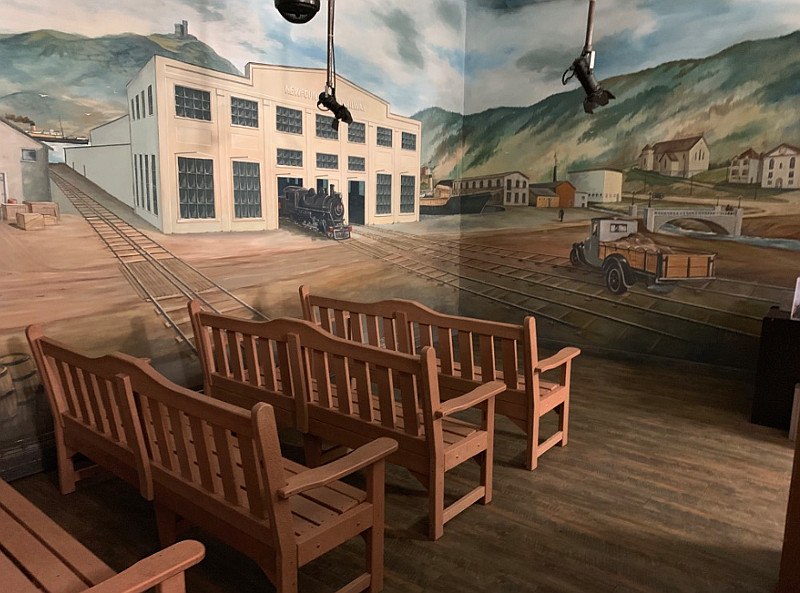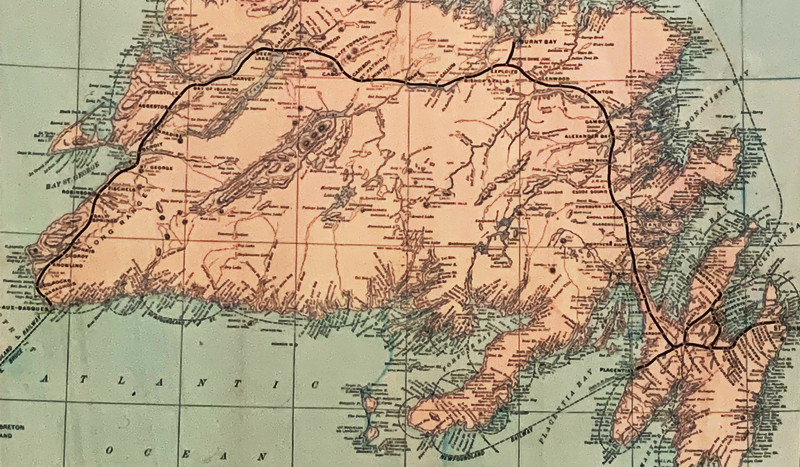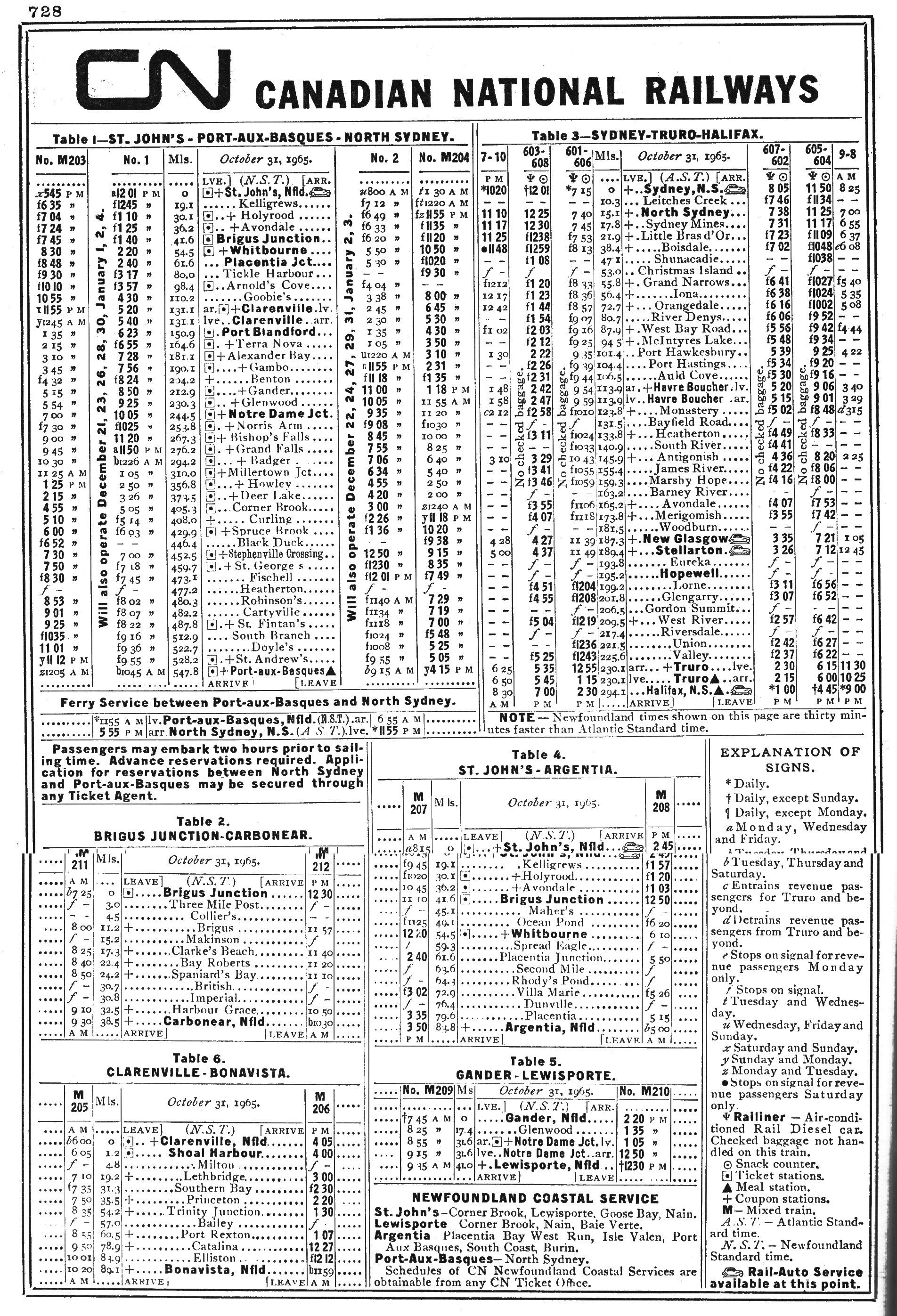| Travelogue observations - 7th September 2019 - Story of a Canadian Railway Posted by grahame at 10:40, 7th September 2019 |     |
Yesterday, I was in the Newfoundland port and capital of St. Johns and visited the Railway and Coastal Museum

The Newfoundland Railway was built late in the Victorian era from St John's on the eastern seaboard of the island of Newfoundland though the sparsely populated interior of the island. Half a dozen branches were built, with a couple further proposed but not built / completed. Competition and a second station in St John's ensured - though there remained just a single main line, with passenger trains taking some 26 hours to make the journey all the way (some 300 miles) to Port aux Basques on the west of the island for the ferry crossing to the mainland.

The economics of the line were such that it was supported by the Government of Newfoundland (a UK colony at the time) from 1923, through pressure from the private company that was loosing money had over fist – to the extent they shut it down for a week to force the government through.
The second world war brought tremendous activity, including construction traffic for Gander airport; after the way - in 1949 - Newfoundland became a pat of Canada (the final addition) and the railway became a part of the Canadian National Railway. Between 1953 and 1956 all the steam locomotives were replaced by diesels. Personalised pullman meals were replaced by a common catering offering right across Canada. The coming of the private motor car for the masses in the following years lead to s shrinkage of traffic, and in 1968 passenger trains were supplemented by buses. Passengers apparently preferred the buses five to one, and the final main line passenger train ran the following year. Which left freight on the main line, and mixed trains on some of the branches. There were some short runs on the main line - for example local runs out of Port aux Basques; I'm not sure when they ceased.

Come the 1980s, and the remaining parts of the system - especially the branches - were in a poor state. Branches fell in the early 1980s, and the final main line train ran in 1988, closing the entire system. Through remote country, the infrastructure cost of maintaining rail and building road was high, and the savings made by closing the railway and letting the infrastructure return to nature (or rather become a walking path) allowed road improvements to be financed from what had been fairly basic up to that point.
What's left? The Station building set amongst the dockside roads in St Johns. The lower floor a small but well done museum, the upper floors let to a business. 2 carriages and a diesel locomotive outside on a piece of track just long enough to save them the indignity of being on bare earth, and a maintenance vehicle on another short piece. I understand a steam locomotive is preserved similarly at Corner Brook, together with another small museum. Walking around St Johns and the dockyard area, you wouldn't otherwise imagine there had ever been a railway there, even though it was still operation as recently as 1988 - St John Station closed after Melksham had been re-opened!

With the exception of that last comment – the railway line closing in Newfoundland and a time of the first (Speller) re-openings in the UK, I am struck by the similarity of dates in the UK and in Newfoundland:
* The more remote rail lines opening late in the Victorian Era
* Problems after the first world war resulting in a reorganisation / grouping in 1923
* High activity during the second world war, but leaving a system that needed a structural admin change in 1948/9
* Dieselisation / modernisation in the 1950s
* A failure of modernisation to save the whole system, resulting in significant reductions in the 1960s.
Then it changes... in Newfoundland, the system was swept away in the 1980s... is that what would have happened under Serpell... in England, with no rails beyond Plymouth of even Exeter, for example – loss of the complete Cornwall network. Will the Canadians regret loosing quite so much rail in the future, as we do for Beeching?
| Re: Travelogue observations - 7th September 2019 - Story of a Canadian Railway Posted by Red Squirrel at 11:07, 7th September 2019 |     |
...
Then it changes... in Newfoundland, the system was swept away in the 1980s... is that what would have happened under Serpell... in England, with no rails beyond Plymouth of even Exeter, for example – loss of the complete Cornwall network. Will the Canadians regret loosing quite so much rail in the future, as we do for Beeching?
Then it changes... in Newfoundland, the system was swept away in the 1980s... is that what would have happened under Serpell... in England, with no rails beyond Plymouth of even Exeter, for example – loss of the complete Cornwall network. Will the Canadians regret loosing quite so much rail in the future, as we do for Beeching?
Thanks for a fascinating insight grahame.
According to Wikipedia, Newfoundland has a population of 519,716 and an area of 405,720km2 whilst Cornwall has a population of 563,600 and an area of 3,562km2 - so perhaps it's not that surprising that railways have survived in Cornwall but not in Newfoundland...
| Re: Travelogue observations - 7th September 2019 - Story of a Canadian Railway Posted by Oxonhutch at 11:53, 7th September 2019 |     |
From a lovely and informative book that I bought on my first visit to Canada:
Andreae (1997) ‘Lines of Country: An Atlas of Railway and Waterway History in Canada’, Boston Mills Press, 228 p, ISBN 1-55046-133-8.
Charts the rise and fall of the railways of Newfoundland amongst others. A wonderful browsing volume.
| Re: Travelogue observations - 7th September 2019 - Story of a Canadian Railway Posted by grahame at 14:44, 7th September 2019 |     |
Charts the rise and fall of the railways of Newfoundland amongst others. A wonderful browsing volume.
An excellent attachment thank you - far better than anything I had found.
| Re: Travelogue observations - 7th September 2019 - Story of a Canadian Railway Posted by grahame at 17:12, 7th September 2019 |     |
According to Wikipedia, Newfoundland has a population of 519,716 and an area of 405,720km2 whilst Cornwall has a population of 563,600 and an area of 3,562km2 - so perhaps it's not that surprising that railways have survived in Cornwall but not in Newfoundland...
Indeed - I picked the Cornish comparison somewhat for topicality as we're a GWR forum. It would be closer to compare the Highland lines beyond Inverness, or the West Highland once past Craigendoran. There were also very interesting proposals at the very end of the Victorian era for light rail lines on Skye and Lewis / Harris that Neve went beyond the proposal stage. Had they been built ...
| Re: Travelogue observations - 7th September 2019 - Story of a Canadian Railway Posted by ellendune at 20:07, 7th September 2019 |     |
I notice there is a hurricane warning for Newfoundland and other parts of eastern Canada. Keep safe.
| Re: Travelogue observations - 7th September 2019 - Story of a Canadian Railway Posted by grahame at 20:55, 7th September 2019 |     |
I notice there is a hurricane warning for Newfoundland and other parts of eastern Canada. Keep safe.
Thank you. The Cap'n is indeed keepin' us safe and I'll tell you about it tomorrow.
| Re: Travelogue observations - 7th September 2019 - Story of a Canadian Railway Posted by TonyK at 21:40, 7th September 2019 |     |
The Newfoundland Railway was built late in the Victorian era from St John's on the eastern seaboard of the island of Newfoundland though the sparsely populated interior of the island. Half a dozen branches were built, with a couple further proposed but not built / completed. Competition and a second station in St John's ensured - though there remained just a single main line, with passenger trains taking some 26 hours to make the journey all the way (some 300 miles) to Port aux Basques on the west of the island for the ferry crossing to the mainland.
Only one way out of St Johns to Port aux Basques - did they not know that you should never put all your Basques in one exit?

A very good account Graham - thank you! I have visited Canada, although not Newfoundland and Labrador, and enjoyed trips on the railway, which is just so different to what we are used to.
| Re: Travelogue observations - 7th September 2019 - Story of a Canadian Railway Posted by CyclingSid at 07:41, 8th September 2019 |     |
You can probably guess where this is going! What happened to the route of the old railway? Great potential as a walking/cycling route.
| Re: Travelogue observations - 7th September 2019 - Story of a Canadian Railway Posted by grahame at 09:07, 8th September 2019 |     |
Would you be looking for something like https://www.trailway.ca (Site does not load well from where I am with limited access)
Newfoundland T'Railway Council
The Newfoundland T'Railway Council is a non-profit corporation dedicated to the development of a recreational trail from St. John's to Port aux Basques using the former Canadian National railway line. Its mandate is to promote multi-use trail development and to preserve abandoned railway lines for future use such as hiking, biking, equestrian, snowmobile, ATV and cross-country ski trails. Other uses like dog sledding and snowshoeing may be appropriate in certain regions.
Known as the Newfoundland T'Railway Provincial Park, the rail bed route extends for 883 km (548 miles) linking urban, rural and wilderness areas. The park forms the Newfoundland section of the Trans Canada Trail stretching from St. John's, NL to Victoria, BC and to Tuktoyaktuk, NWT. When complete, the Trans Canada Trail will extend for more than 22,000 km, making it the longest continuous trail in the world.
The Newfoundland T'Railway Council is a non-profit corporation dedicated to the development of a recreational trail from St. John's to Port aux Basques using the former Canadian National railway line. Its mandate is to promote multi-use trail development and to preserve abandoned railway lines for future use such as hiking, biking, equestrian, snowmobile, ATV and cross-country ski trails. Other uses like dog sledding and snowshoeing may be appropriate in certain regions.
Known as the Newfoundland T'Railway Provincial Park, the rail bed route extends for 883 km (548 miles) linking urban, rural and wilderness areas. The park forms the Newfoundland section of the Trans Canada Trail stretching from St. John's, NL to Victoria, BC and to Tuktoyaktuk, NWT. When complete, the Trans Canada Trail will extend for more than 22,000 km, making it the longest continuous trail in the world.
| Re: Travelogue observations - 7th September 2019 - Story of a Canadian Railway Posted by CyclingSid at 06:59, 9th September 2019 |     |
Does not load very well from here! But I get the drift.
| Re: Travelogue observations - 7th September 2019 - Story of a Canadian Railway Posted by grahame at 19:21, 25th November 2019 |     |
From something I picked up in Birmingham (West Midlands not Alabama) ... 1966 timetable for the railway gone











